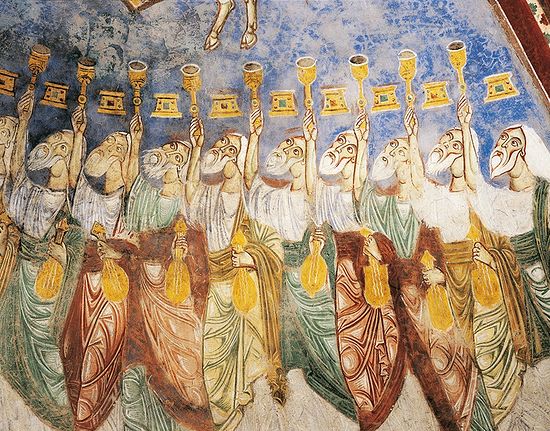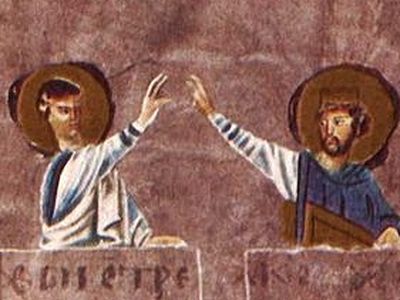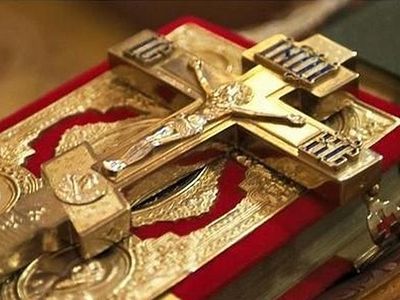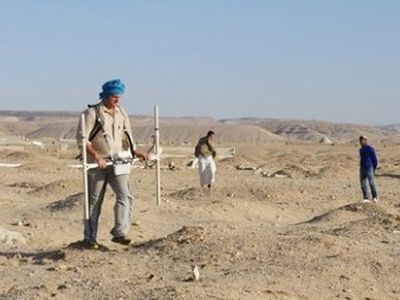According to the Old Testament, the heavenly or divine council is the host of angels surrounding God, “advising” Him.
You see this theme in Job 1–2, 1 Kings 22, and so on. But the theme begins all the way back in the first chapter of Genesis.
In the Beginning
In the beginning, God created the heavens and the earth—but only the earth was without form, void, and dark. God spends six days forming, filling, and brightening the earth, bringing it closer to the fullness of its heavenly model.
Man is called in Genesis 2:4 the generations of the heavens and the earth. He is the son of the Spirit of God (heaven) and the dust of the ground (earth). As he grows in communion with God, he will pull the material creation with him. This is why Christ in 1 Corinthians 15 is the heavenly man.
God made a soulish body in Genesis 2, but the resurrected body is a spiritual body. It is fully animated by the Holy Spirit, and Christ as Last Adam brings the whole creation up with him.
Angels are the persons inhabiting the heavenly realm.
They have a single free choice, after which their will is fixed. They are fully in communion with God (angels) or fully wicked (demons). They don’t change or mature or repent. This is why, after all, they are neither married nor given in marriage. God creates them as a host.
By contrast, God creates a single man, pulls a woman from his side, and commands man to gradually multiply into a host. Hence, in the eschaton, man is “like the angels.” The human race is fully mature, it has reached the fullness of its population, and the creation is fully glorified. Christ, as in Ephesians 1, has united heaven and earth in himself. This is the goal towards which the whole Bible strains, from Genesis through Revelation.
(As a footnote, in the old covenant, the demons were on the heavenly council too. We see Satan cast out from God’s council in Revelation 12. More on this soon, because the council of God is a major theme in Revelation.)
The Royal “We”
In Genesis 1, God addresses His council. This is why God says let us. This ought not to be opposed to the Trinitarian reading, because the plurality of God is the very foundation for God’s communion with created persons.
Created persons are incorporated into the intercommunion of the divine persons. We see another “plural” passage in Isaiah 6, where it is clearly God addressing His council. The council-reading is the foundation for what we read in Job—as God was creating the world, the angels (sons of God) were singing for joy by His side.
But the heavenly council theme doesn’t end in Genesis 1. It is a major part of Genesis 2–3.
What is the tree of the knowledge of good and evil? The Fathers of the Church saw it as a tree of deification. God desires us to be divinized, but we are divinized through the Holy Spirit. We can’t raise ourselves up.
Adam, then, was to eat of the tree eventually (cf. Gen. 1: “all the trees shall be food for you”)—but he was supposed to wait.
Waiting for the Tree
Are there foundations for this in the biblical text? Absolutely.
Consider the following:
- The tree is called the tree of the “knowledge of good and evil.” This phrase is used elsewhere in the Bible—see, for example, the messianic prophecy of Isaiah 7. Before the boy knows how to refuse the evil and choose the good. This doesn’t mean he has no moral knowledge, but this means “before He is old enough to be king.” You can see this in 1 Kings –3 as well. Solomon asks for the wisdom to discern between good and evil. This is the wisdom for kingship. So the tree of knowledge is about kingship.
- The “waiting for enthronement” theme is central from Genesis through the rest of Scripture. Adam was meant to go to the tree of life before the tree of knowledge. He would acknowledge first that all life comes from God. He couldn’t exalt himself to be king. Similarly, Abraham has to wait, and wait, and wait, and wait for his son, through whom he will be constituted “heir of the world.” Then when he gets his son, he has to sacrifice him- in other words, Abraham has to acknowledge that the life of his son comes from God and only from God. This theme grows in the life of Joseph. Joseph has to suffer for years and years and years, but through his suffering, he grows and matures, until the Egyptians say they need a “wise and discerning man” (Eve saw that the tree was good for becoming wise), so they chose Joseph and he was exalted and fed the nations with bread and wine.
- Kingship is associated with deification. Philippians 3:20–21 says that our resurrected bodies will be animated by the divine glory, the same glory that enables Christ to subject all things to Himself. Since the whole creation exists in virtue of its participation in the divine glory, the glory of Christ is the means by which He rules the world.
Enthronement and Mountains
But what about the heavenly council?
After Adam eats, God says to His council that Adam has become “as one of us, knowing good and evil.” The knowledge of good and evil is about enthronement, and the angels are the ones enthroned in council around God.
The symbolic structure of the holy mountain buttresses this. The top of the mountain corresponds to the Holy of Holies, and in the Holy of Holies you have God’s throne (the Mercy Seat) attended by two cherubim.
In Isaiah 14, Satan—personified as the king of Babylon, the true ruler of the city of man—desires to ascend above the “stars of God” which is a reference to the heavenly council. In Genesis 2–3, the Garden-Sanctuary is in the middle portion of the mountain, corresponding to the Holy Place. Adam is not fallen, but he is a spiritual infant. He is not yet prepared to ascend into the Holy of Holies, the throne-room of God.
The Tree of Knowledge is about enthronement through divinization. Adam attempted to seize the throne before he was ready, and Christ as Last Adam humbled Himself and awaited enthronement on God’s time. A key story of the Scriptures is how Christ accomplishes this deification of man, and how we, in Him, can become “sons of God” (language referring to the heavenly council, as in Job 1–2), being “seated in Heaven with Christ.”
Before I proceed to Revelation, I want to show how the role of the prophet plays into all of this.
Prophets and the Divine Council
A prophet is a member of God’s heavenly council. This is perhaps most evident in Isaiah 6.
The seraph brings Isaiah a coal flaming with the divine glory and touches it to Isaiah’s lips, thereby filling him with the divine glory. As this glory is the means by which a person gains a seat on God’s council, so Isaiah gains a seat. When the Lord then asks whom He shall send, Isaiah is on the council, willing and able to respond.
Prophets are not merely appointed to preach. Instead, they are appointed as special intercessors for the people of God, by and through their communion with the Holy Spirit:
Then God said to him in the dream, “Yes, I know that you have done this in the integrity of your heart, and it was I who kept you from sinning against me. Therefore I did not let you touch her. Now then, return the man’s wife, for he is a prophet, so that he will pray for you, and you shall live. But if you do not return her, know that you shall surely die, you, and all who are yours.” —Gen. 20:6–7
God is speaking directly to Abimelech and yet he asks him to request the prayer of Abraham!
This is why prayers directed towards God do not invalidate the intercession of Saints. The intercession of prophets is something requested by God. Abraham’s prayer is justified by his prophetic status.
This appears elsewhere in Scripture as well. After Israel worships the Golden Calf, for example, the Prophet Moses personally intercedes with God for forgiveness.
Prophets are prophets because they are full of the Spirit of God. And since they are filled with the Spirit, they have contact with all those God has contact with—namely, the heavenly council. God animates them and speaks through them.
And Scripture tells us that in the new covenant, all of God’s people will become prophetic.
Flaming Seraphim to the Day of Pentecost
The seraphim are members of God’s council. They are “burning.”
Isaiah becomes a member of God’s council by eating a flaming coal—he becomes “burning.” The seraphim cry “Holy, Holy, Holy,” and Isaiah’s favorite title for God is “Holy One of Israel.”
Additionally, Isaiah is filled with prophecies that God is going to set Israel on fire, and through Israel, he will subsequently torch the nations—which in this case is a good thing. God is to pour out His fiery Spirit on the entire human race.
This theme is explicit in Joel’s prophecy of Pentecost:
And it shall come to pass afterward, that I will pour out my Spirit on all flesh; your sons and your daughters shall prophesy, your old men shall dream dreams, and your young men shall see visions. Even on the male and female servants in those days I will pour out my Spirit. —Joel 2:28–29
This itself is an allusion to Numbers 11:29 and 12:5–8:
But Moses said to him, “Are you jealous for my sake? Would that all the Lord’s people were prophets, that the Lord would put his Spirit on them!”
And the Lord came down in a pillar of cloud and stood at the entrance of the tent and called Aaron and Miriam, and they both came forward. And he said, “Hear my words: If there is a prophet among you, I the Lord make myself known to him in a vision; I speak with him in a dream. Not so with my servant Moses. He is faithful in all my house. With him I speak mouth to mouth, clearly, and not in riddles, and he beholds the form of the Lord. Why then were you not afraid to speak against my servant Moses?”
Joel uses this very text from Numbers to predict the great day of Pentecost following Christ’s Ascension. Since Numbers 11 is discussing the hope that all the Lord’s people would become prophets, this is the hope fulfilled in Joel.
The Apocalypse of Jesus Christ
Now, let’s turn to the book of Revelation.
I am a preterist, but I think most preterist readings of Revelation are insufficient. Revelation is not merely about a Jewish-Roman war, but is rather more fully about the Apostolic Age and the sufferings-unto-glory of the Church.
It doesn’t prophesy battle movements. It does prophesy the fall of Jerusalem, but that because of its importance in bringing the old covenant to its fulfillment in the new. And what do we know about the old covenant? We know that it was a covenant of angels.
This is what the apostle Paul writes in Galatians—the Torah was given through angels. Paul knows this because in the Old Testament, when the glory-cloud descended and a prophet entered into it, he saw God’s council of angels. That cloud descended on Sinai, swirling with angels.
The leader and head of those angels was the Second Person of the Trinity acting as the “Angel of the Lord.” He was the chief of God’s angelic hosts (I am not suggesting an incarnation into angelic nature, but “head” in a symbolic sense.).
Psalm 8 tells us that God made man “for a little while” lower than the angels, but that man would ultimately be “crowned with glory and honor.” Hebrews tells us that Christ is now crowned with glory and honor. In Christ, man has grown up.
The Angelic End and the Raising of Man
Revelation marks the end of the old covenant.
It marks the end of the covenant of angels.
In Revelation 4–5, we see “twenty-four elders.” We know these are angels and not men, for if you count the angels in Revelation, it comes out to exactly twenty-four. In order to do this, however, one need to subtract the character called “Another Angel.” The “Another Angel” is Jesus Christ, acting as the Angel of Yahweh, ending the covenant governed by angels.
This becomes apparent when “Another Angel” takes on theophanic characteristics.
In Revelation 10, He has attributes attributed to one “in the likeness of a man,” seated upon God’s throne in Ezekiel chapter 1. In Revelation 8, He takes fire from God’s altar—the same fire that constituted Isaiah as a prophet—casting it upon the Earth. This fulfills Christ’s words in the Gospel of Luke, that He came to “cast fire on the Earth.”
Revelation 8 reveals Christ doing just this. It is a vision of Pentecost from the heavenly throne-room.
In Revelation 4–5, the elders cast their crowns before God. This is because the angels are preparing to hand over the keys to mankind. Then, each angel will perform an action and walk off stage. Some will blow trumpets, others will pour bowls, others will do yet something else.
And in Revelation 20, these angels are replaced by men.
In Revelation 6, the martyrs cry out for God to judge the Earth. But here, God invests themwith the authority to Judge:
Then I saw thrones, and seated on them were those to whom the authority to judge was committed. Also I saw the souls of those who had been beheaded for the testimony of Jesus and for the word of God, and who had not worshiped the beast or its image and had not received its mark on their foreheads or their hands. They came to life and reigned with Christ for a thousand years. The rest of the dead did not come to life until the thousand years were ended. This is the first resurrection. Blessed and holy is the one who shares in the first resurrection! Over such the second death has no power, but they will be priests of God and of Christ, and they will reign with him for a thousand years. —Rev. 20:4–6
“I saw thrones” is a quotation from Daniel 7. The whole of Revelation, it would seem, takes place within the vision and context of Daniel 7.
Ascending and Ascending
Daniel sees the “Son of Adam” ascending to the throne of God. This comes from Leviticus 16, where the High Priest—an Adam—ascends upon a cloud of incense to the throne of God twice. He ascends once for himself, and once for his people.
Daniel 7, then, prophesies a double ascent.
In the Gospel of John, Jesus predicted His ascension to the Father. This ascension is revealed in Revelation 4–5 and is the first ascent of the Son of Adam as High Priest. The second ascent is when Jesus brings His people up with Him, as revealed in Revelation 20. Together, this reveals the truth of our Lord’s words in John: “I go to prepare a place for you.” Over and over again, the book of Revelation fulfills texts in John’s Gospel.
The “first resurrection” is Christian death, described first in Revelation 14:
Here is a call for the endurance of the saints, those who keep the commandments of God and their faith in Jesus. And I heard a voice from heaven saying, “Write this: Blessed are the dead who die in the Lord from now on.” “Blessed indeed,” says the Spirit, “that they may rest from their labors, for their deeds follow them!” —Rev. 14:12–13
That the first resurrection is identical with Christian death is evident in how the passage is structured.
The “second death” is the resurrection of the wicked. The “first resurrection” is the death of the Christian. The message is that the Christian, having died already with Christ, shall never die again. As the Lord says in the Gospel of John, “Those who live and believe in me shall never die.” This text in Revelation fulfills these words in St. John’s Gospel.
The “second death” reveals the nature of the resurrection of the unjust. Because death is aseparation, their resurrection is simply eternal death, because their persons eternally will against their nature; they are eternally divided.
A Dedicated Head
The crowns cast down by the angels of Revelation 4–5 are received by men in Revelation 20. Symbolically, half the thrones are occupied by the 144,000, the Saints of the new covenant. They are marked on the head in Revelation 7, and they are “beheaded” in Revelation 20. This is the fulfillment of their Nazarite vow.
In Numbers, the Nazarite quite literally has a “dedicated head.” The Nazirite’s offering of his hair is a beheading! This is why John the Baptist—the ultimate Nazarite—is beheaded. The Nazarite enters his Sabbath rest by beheading, and the Sabbath is enthronement.
(144,000 is, of course, 12,000 x 12, so 12 of the thrones go to them.)
The other 12 go to the saints of the old covenant who, since Abel, have been waiting to ascend. Revelation 6 sees them “under the altar.” How long, O Lord? As Christ says, all blood from Abel to Zechariah rests on Jerusalem.
The saints of both old and new covenants now sit together on the heavenly thrones of Revelation 20.
What Does it All Mean?
Let’s take a moment to summarize what we’ve seen to this point:
- The role of prophets is to intercede, and that prophets have a seat on God’s heavenly council.
- We are all made prophets at Pentecost.
- The dead in Christ occupy a special place in God’s divine council.
And now we have but one final question to ask:
Can we ask the Saints for their prayers—even while we sojourn here on earth—since they are seated on God’s heavenly council?
The Lesser and Greater Prophets
With this query in mind, we return again to the book of Numbers:
And the Lord came down in a pillar of cloud and stood at the entrance of the tent and called Aaron and Miriam, and they both came forward. And he said, “Hear my words: If there is a prophet among you, I the Lord make myself known to him in a vision; I speak with him in a dream. Not so with my servant Moses. He is faithful in all my house. With him I speak mouth to mouth, clearly, and not in riddles, and he beholds the form of the Lord. Why then were you not afraid to speak against my servant Moses?” —Num. 12:5–8
There is a lesser prophet and a greater prophet.
All Christians are lesser prophets. The Saints—both those achieving extraordinary sanctity while on Earth and those alive in Christ in Heaven—are the “greater prophets.”
What distinguishes a lesser prophet from a greater prophet (as with the Saints) is “beholding the form of the Lord.” The Saints have vision of the divine glory. They are in such close communion with God, they know intuitively and exactly His will—without needing to study it out.
Returning back to Revelation 20:
Then I saw thrones, and seated on them were those to whom the authority to judge was committed. Also I saw the souls of those who had been beheaded for the testimony of Jesus and for the word of God, and who had not worshiped the beast or its image and had not received its mark on their foreheads or their hands. They came to life and reigned with Christ for a thousand years. The rest of the dead did not come to life until the thousand years were ended. This is the first resurrection. Blessed and holy is the one who shares in the first resurrection! Over such the second death has no power, but they will be priests of God and of Christ, and they will reign with him for a thousand years. —Rev. 20:4–6
Read carefully, Revelation 20 presents two categories:
- Those raised from the dead in the first resurrection. These are those who have a blessed repose in Christ.
- Those who have a “share” in the first resurrection. Through the intercessions of Saints in Heaven, they reign upon the Earth, subjecting the nations underneath Christ’s triumphant feet.
The former corresponds to the greater prophet, the latter to the lesser.
Concluding Remarks
And this is the Scriptural foundation for the invocation of Saints.
Those who have died in Christ are “greater prophets,” and prophets are intercessors. We know they hear our prayers since they are in direct and intimate communion with the Holy Spirit.
Christ knows everything—even in His glorified human mind. We participate in Christ through the Spirit, and those in deep contact with the Spirit participate in this all-knowing.
For those who reach this degree of sanctity in our present, evil age, we can see this ability in action. Even before he died, St. John Maximovich (reposed in the 1960s) knew precisely who needed his prayers, and would often see someone—whom he had never met in person—calling them by name, telling them that he had been praying for a particular need that was on their heart.
And again, this even if they had never spoken or met before.
The traditions of the Orthodox Church can appear strange to many. Many justifiably wonder how they are rooted in the Holy Scriptures.
It has been my intent to show how a canonical, unified reading of the Scriptures reveals the answer to this very question.
The Saints surround God in His heavenly council. And on that council, they offer prayers and intercessions for us in the here-and-now.
How thankful we ought to be for this glorious blessing in Christ.





